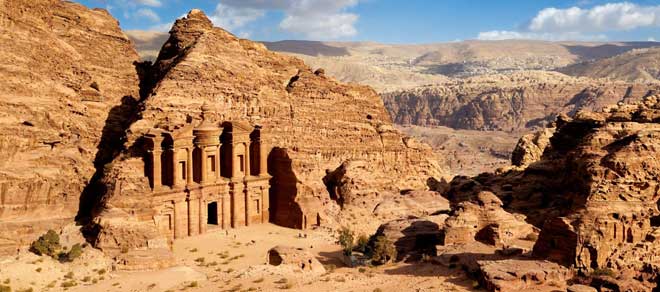Petra Citadel: Wonders of the modern world
About 185km southwest of Jordan's capital Amman is an ancient city carved into the rock with natural beauty and splendid ancient architecture. This ancient city that attracts tourists from all over the world is the Ancient City of Petra, also known as Jordan's "rose city" Petra. Known by its ancient name Rekem, Petra was the capital of the Kingdom of Nabatea of the Nabataean people, Aramaic-speaking Semites. Petra means “rock”. In the ancient Semitic language of the Middle East, people called Petra Raqmu - "multi-colored". No one knows when Petra was formed. Just know that this land is located in a prime location for trade, located on the trade route connecting ancient West Asia and Egypt.
Known by its ancient name Rekem, Petra was the capital of the Kingdom of Nabatea of the Nabataean people, Aramaic-speaking Semites. Petra means “rock”. In the ancient Semitic language of the Middle East, people called Petra Raqmu - "multi-colored". No one knows when Petra was formed. Just know that this land is located in a prime location for trade, located on the trade route connecting ancient West Asia and Egypt.
Concealed by rising cliffs and watered by an inexhaustible year-round stream, Petra not only had the advantages of a fortress but also controlled the main trade flows that passed through it to Gaza in west, Bosra and Damascus in the north, to Aqaba and Leuce Come on the Red Sea, and across the desert to the Persian Gulf.
Excavations demonstrate the possibility that the Nabataean people controlled the water supply leading to the development of the city in the desert, creating an artistic oasis.
The area was also affected by flash floods and archaeological evidence shows how the Nabataean people coped with the floods using dams, cisterns and aqueducts.
Thus, the stored water could be used during periods of prolonged drought, and the city got rich by selling the water. The city's prosperous period took place about 2,000 years ago with an estimated population of 20,000 people and great constructions: theaters, mausoleums, temples... Surrounded by fertile fields and gardens. Irrigated by an elaborate system of canals, dams and reservoirs.
The city's prosperous period took place about 2,000 years ago with an estimated population of 20,000 people and great constructions: theaters, mausoleums, temples... Surrounded by fertile fields and gardens. Irrigated by an elaborate system of canals, dams and reservoirs.
The Romans annexed this land and gradually gained dominance over the precious trade route. Petra continues to grow and flourish. But between the 4th and 7th centuries AD, the city was devastated by a series of strong earthquakes. Petra was abandoned and gradually fell into oblivion.
In 1812, Swiss explorer Johann Ludwig Burckhardt discovered and announced to the world the beauty of Petra. The area was recognized as a UNESCO World Heritage Site in 1985 and described as “one of humanity's most precious cultural assets.” On July 7, 2007, Petra was recognized as one of the 7 wonders of the modern world.
Petra is famous for its temples and mausoleums, most of which were built on the edge of the city, above the main street. Some tombs are simply designed, containing numerous burial pits in an unadorned stone mausoleum, while others are elaborately designed. Petra's most famous tomb is Khazneh, which in Arabic means "Treasure". So called because local people once believed that the tomb contained secret treasure. Archaeologists call it a two-story high mausoleum. The facade size is measured with a height of 39m and a width of 25m. With a design mainly following the Greek structure, right from the outside one can see columns built in the Corinthian style, vertical walkways with images depicting the legendary twin brothers Castor and Pollux. Above the center is a woman who may be a representation of Isis, an Egyptian god.
With a design mainly following the Greek structure, right from the outside one can see columns built in the Corinthian style, vertical walkways with images depicting the legendary twin brothers Castor and Pollux. Above the center is a woman who may be a representation of Isis, an Egyptian god.
Also shown there are images of six legendary female warriors from the ancient world. The illustrations also include griffins, eagles, two winged animals considered symbols of victory, and images of plants such as poppies, grapes and pomegranates. A rose, the symbol of the royal family, is also seen here, indicating that this is the tomb of a king
Contrary to the sophisticated appearance on the outside, the inside of the tomb is designed quite simply with a corridor leading to 3 rooms, the largest room is located in the center with a length of 12.5m, 11m wide and about 10m high.
There is no description of who was buried in the tomb or exactly when it was built. But according to researcher Andrew Steward, it may be the tomb of King Aretas IV, who died in 15 AD, and his two wives.
Besides the splendid Khazneh tombs, three ancient temples are also highlights of the architecture as well as the rich religious life of Petra's ancient residents. One of them is Oasr al-Bind. The temple's wall is still preserved with a height of 23m. One person will have to climb 19 steps to the stop and then 8 more steps through 4 pillars to reach the temple's corridor before reaching a main hall with each side of the hall measuring about 28m. At the end is the Holy of Holies. Coming to Petra not only means coming to thousands of years of architectural works but also coming to the harmony between a peak culture and majestic nature.







































